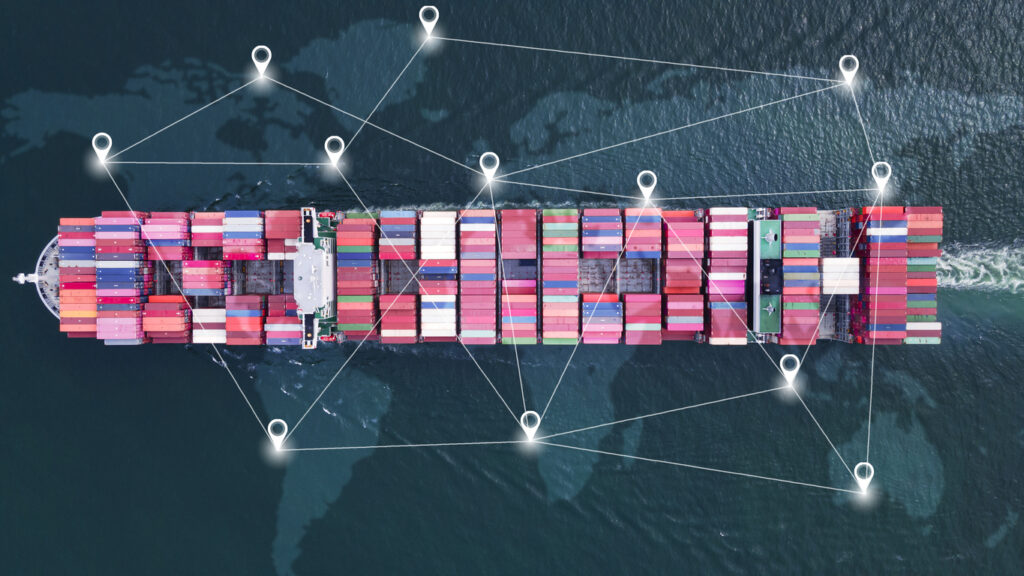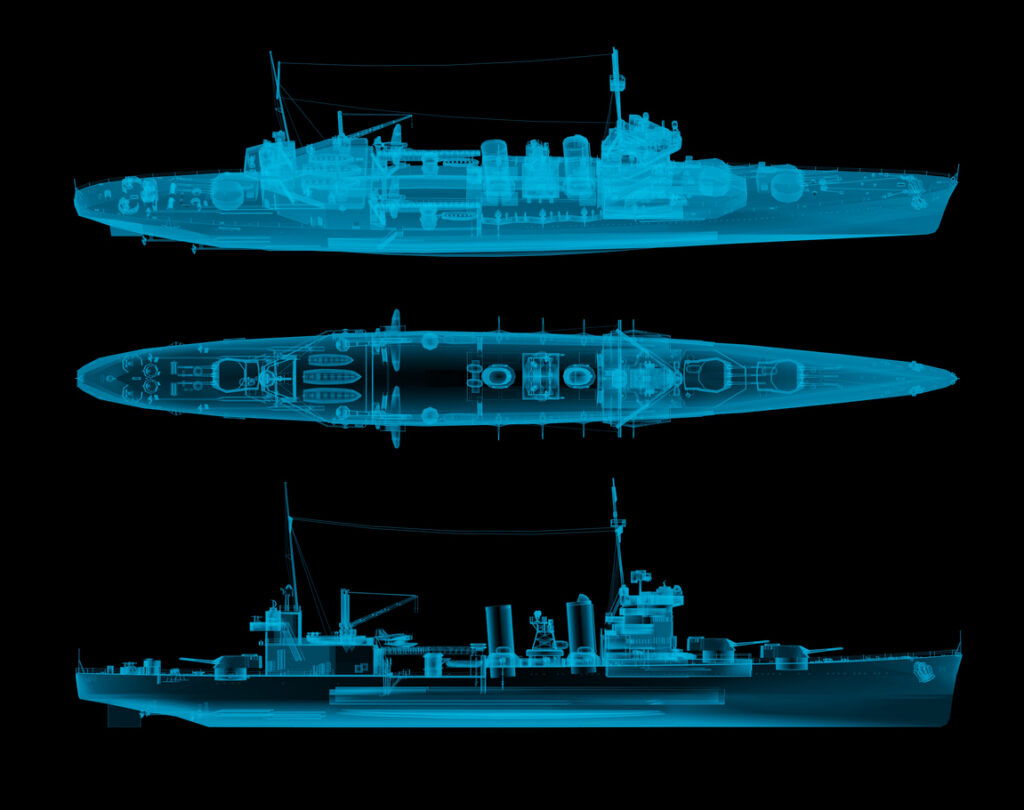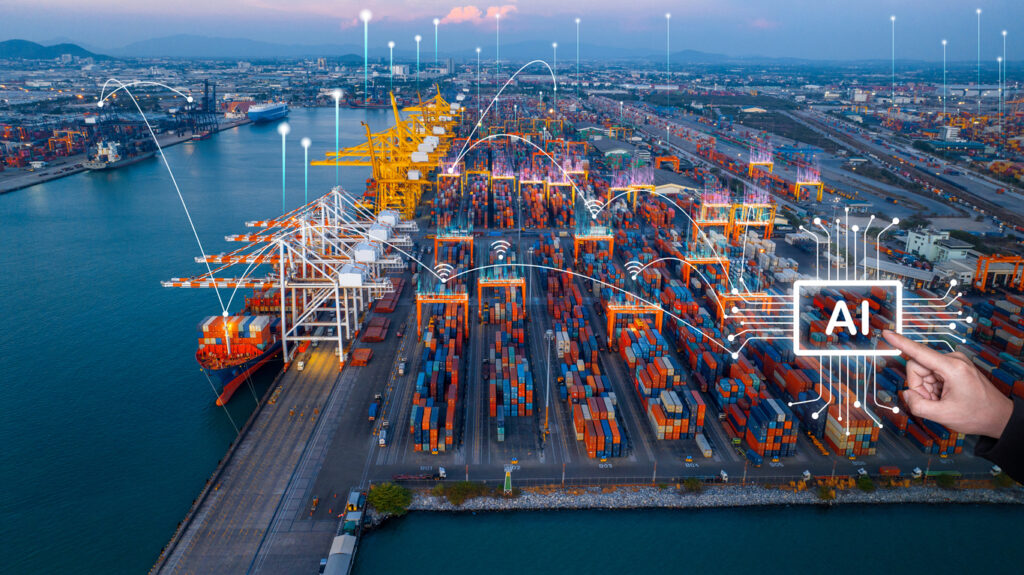Over the last two decades, the uptake of artificial intelligence (AI) in business processes has revolutionised the way we operate, and that rings true for the shipping industry too.
As the maritime industry evolves, AI is playing a more prominent role in shipping operations as companies try to stay competitive and ahead of the curve. In fact, according to a 2023 joint report by Lloyd’s Register and maritime innovation consultancy, Thetius, the AI-driven systems and vessel autonomy markets will be worth a combined $5.01 billion by 2028. Besides focusing on financial survival in the future market, there are also innovations which can have a favourable effect on our planet.
The maritime industry is responsible for transporting over 90% of the world’s commerce, and in doing so produces 3% of the planet’s greenhouse gas (GHG) emissions. With growing concerns about the effects of climate change, there is more pressure on industries to limit their carbon footprint. The International Maritime Organization has set lofty ambitions for 2030 and 2050. By 2030, the United Nations agency wants to reduce carbon emissions by 40% from 2008 levels, and by 2050 to at least halve all of the industry’s emissions.
Implementing machine learning algorithms that recommend the least energy-intensive routes, the most efficient use of resources, and automated container configuration that improves space management can help the cause. Introducing AI processes into shipping operations has a wealth of benefits. In this article we’ll explore the potential of AI, whilst looking at the benefits and any challenges that might have to be considered.
The benefits of using AI in shipping operations

We’ve already touched upon a few benefits of applying AI systems into shipping processes, but some of the main reasons for adopting AI are listed below:
Reduces chance of human error
Regardless of the job, industry, or level of skill of an individual, humans make mistakes. During data collection, it’s not uncommon for incorrect figures to be input into systems. AI data tracking software which automates processes like positioning, planning and calculation can virtually eliminate this risk.
Reduces costs
AI data tracking and analytics help spot expensive activities and poor resource utilisation. Finding areas where you are overusing resources can be done by analysing fuel use. Crews can come up with plans to use less fuel, which will assist in keeping expenses down for the company. Other procedures, such as more effective routes and improved maintenance, also consume less fuel, which lowers the cost of each voyage for the ship. Crews can make adjustments to reduce costs on the water because AI combines current conditions with past and expected data.
More sustainable
Upholding sustainable practices is a top goal for many organisations, and the maritime industry should contribute to a greener planet in any way that it can. AI can aid attempts to cut waste and carbon emissions by analysing resource consumption. Monitoring the burning and use of fuel can show whether emissions are declining or show whether ships are using more limited resources than necessary. When crew members are aware of how their actions affect the environment, they can more effectively implement new sustainable practices.
Improves efficiency
Ships utilising AI and machine learning can assist sailors in maintaining and raising efficiency standards by automating navigation, simplifying routes, and gaining access to ports. Through the use of automated features, teams can delegate computer-based duties like data collecting and navigation, freeing up their time to concentrate on other crucial tasks that demand their attention. Crew members can respond swiftly to changing circumstances thanks to real-time data collection, and they may use prior data to be more proactive and deal with issues more effectively.
Better safety precautions
Artificial intelligence can be helpful in forecasting behaviour by predicting adverse weather conditions and acting accordingly. Collision avoidance systems are another feature which provide a safer working environment for the crew.
Autonomous ships – the future of shipping?
In 2022, the first zero-emission, fully autonomous container ship set sail in Norway, starting a two-year trial. The Yara Birkeland was launched as a joint-venture between Yara and Kongsberg. The vessel boasts a 7 MWH battery, which holds 1,000 times the capacity of a typical electric car battery. The ship is able to ship 120 containers at an average speed of 10 knots, whilst the largest ships in operation at the moment carry 24,000 and at twice the speed of the Yara Birkeland.
The mission is to transport mineral fertiliser from Yara’s production plant in Porsgrunn, Norway to its distribution terminal in Brevik, Norway. By carrying out the journey on the autonomous shipping vessel, it will remove 40,000 diesel-powered truck journeys every year, reducing carbon emissions, improving road safety and limiting noise pollution.
As a first step towards removing human intervention in the sailing process, the Yara Birkeland is a good start. For short journeys, the autonomous ship is a viable option with the current level of technology, and as the container vessel is on track to help Yara cut its operational costs by 90%, other companies will surely be looking to follow suit.
It could however be decades until we see fully autonomous cargo ships transporting goods around the world. This is due to the fact that the technology needs to be further developed and tested, and also because of the legal and regulatory framework that international ports currently operate under.
How is AI currently streamlining shipping operations?

Route optimisation and navigation
Real-time data-based route forecasting enables businesses to adjust their routes based on factors like the weather and respond to unforeseen situations. The crisis in the Suez Canal in 2021 demonstrated how essential these forecasting models are to the shipping industry. When the most popular marine transit route was completely blocked, shipping companies were forced to improvise and look for the most expedient and cost-effective alternatives. They could get quick estimates from AI technologies and avoid losses in costs and time.
Fuel efficiency
Route optimisation will also help to reduce fuel consumption and waste by limiting idling time and using less-energy intensive alternatives. AI and machine learning are able to monitor the amount of fuel that vessels use and provide ways to cut back for better resource and expense management. Additionally, assessing fuel use can reveal ineffective procedures and help improve all aspects of ship operations. Better fuel efficiency will help to lower carbon emissions, which contributes to the IMO’s targets, and also reduces costs. In the future, alternative fuels are expected to replace conventional fuels such as heavy fuel oil (HFO), further enhancing sustainable operation.
Predictive maintenance
Ship efficiency and safety depend heavily on maintenance. Crews can experience better time and fuel efficiency when their equipment is operating at its peak. Even minor wear and tear can have an influence on a complete system, making it overworked and utilising more fuel and energy, raising vessel costs and consumption. Unnoticed damage might constitute a liability for passages and create significant problems.
AI analyses your equipment’s performance using sensors to spot potential problems. It can notify workers that the machine requires inspection and repair when it notices unusual variations in fuel or energy consumption and heat production. Crew members have a lot of duties, therefore AI equipment monitoring can improve equipment maintenance by enhancing visibility and awareness. With the use of AI, they are able to spot machine problems before they become serious, leading to outages that disrupt the entire supply chain.
The Distrelec webshop stocks a range of sensors from temperature and pressure to optical and inductive.
Port management
Shipping businesses can optimise their vessel scheduling with the use of predictive analytics. To plan their journeys as effectively as possible, they make use of the port calls data that the port community systems provide, such as destination, arrival time, trajectory, and trip duration. The carriers arrange and reschedule arrivals based on traffic pattern data to prevent congestion and reduce the risk of collisions.
AI often works in tandem with robotics in post settings, as many AI systems contain robotic elements allowing machines to complete tasks autonomously. The AI-powered processes can optimise space and container placement, by assessing a container’s size and shape, before analysing the existing storage configuration to identify the correct placement of the container. Containers which are wrongly positioned can be spotted and rearranged to maximise the use of space.
The digital twin, which refers to a complete digital map of all processes taking place within the port context, is a fundamental technology to optimise port efficiency.
Digital twins in the digitalisation of the shipping industry

Data analysis and system monitoring are made possible by fusing the virtual and real worlds in simulations. This prevents unnecessary outcomes, cuts downtime, finds new opportunities, and even plans for the future. The concept of the digital twin can help the maritime industry utilise digitalisation in a way that is more effective and ushers in a new era. Management of the fleet, port effectiveness, and improvement of the end-to-end supply chain are just a few elements that are greatly enhanced by this technology.
Digital twins offer shipping companies, port operators, and other users precise virtual environments to test innovative ideas, fostering innovation across the marine sector. If you want to find out more about the digital twin in other industries, read our article on the subject here.
Considerations for implementing AI in shipping operations
Despite the many advantages of embedding AI into the maritime sector, there are also a few challenges that need to be taken into account to ensure such a transition is successful.
Cybersecurity

With the digitalisation of shipping, and the increased interconnectivity between ships, AI systems and autonomous machinery, there is a greater risk of cyber threats. There are a ton of regulations, enforced by the IMO, the EU and national and regional bodies that require shipowners to have cybersecurity systems in place. Hackers have the ability to steal sensitive information, disable the ship’s external communications, or mess with the navigation systems, potentially causing harm to the crew, as well as the company. Below you can see a few example of the types of cyber threats that can be posed:
- Changing ship data – including position, speed, name, cargo information and route.
- Sending false weather information – this forces vessels to change their course to avoid non-existent bad weather.
- Creating “ghost ships” – these ghost ships appear as normal ships to other vessels, but don’t exist.
- The possibility of carrying out a DoS (denial-of-service) attack on the entire system by initiating an increase in the frequency of transition of AIS (automatic identification system) messages.
- Falsifying EPIRB (emergency position indicating radio beacon) signals which activate alarms on nearby ships.
- Making existing vessels disappear
Fears of being replaced
Artificial intelligence conjures up thoughts of workers being replaced by technology, especially when robots and autonomous elements are involved. Employees may experience anxiety and worry due to this underlying fear. The worst case scenario is that they might sabotage AI programmes or be hesitant to even begin using this technology. If AI initiatives are to be successful, the capacity to address these concerns through open dialogue and training is essential.
Data integration
All parties involved in initiatives involving numerous service providers and supply chains must be willing to offer data and interfaces. Even though these cooperative projects frequently have the highest potential for optimisation for all parties involved, persuading outside parties to provide their data can be challenging.
Conclusion

It’s not hard to see that AI is already having a positive impact on shipping operations, and that it can provide a variety of benefits to the industry. AI systems make tasks and processes more manageable for humans, and this will be priceless as the world continues to evolve. If we can successfully navigate the challenges involved with integrating AI into shipping, then it’s sure to be a successful endeavour for shipping companies to adopt to reduce costs, improve efficiency and achieve targets set by the IMO. There are lots of innovations that have been implemented already, and with exciting prospects like autonomous ships on the horizon, we can expect that AI will continue to make waves in the maritime industry.











